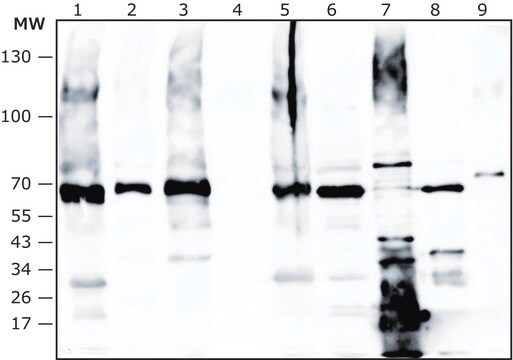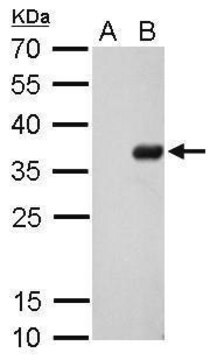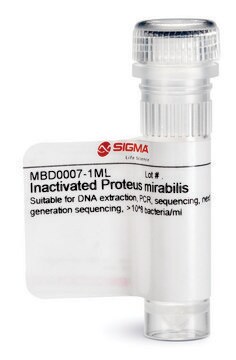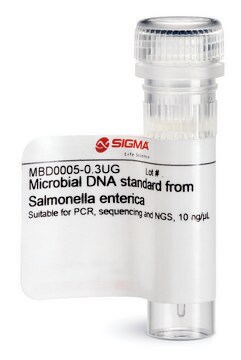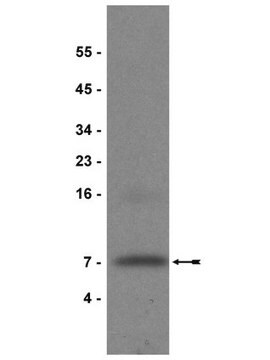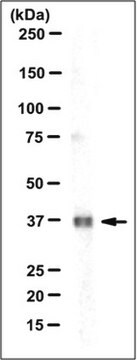全部照片(6)
About This Item
分類程式碼代碼:
12352203
NACRES:
NA.41
無性繁殖:
polyclonal
application:
ELISA (i)
物種活性:
Proteus mirabilis
技術:
immunoblotting: 1:10,000-1:20,000 using Proteus mirabilis LPS
indirect ELISA: 1:16,000-1:32,000
indirect ELISA: 1:16,000-1:32,000
citations:
7
推薦產品
生物源
rabbit
抗體表格
IgG fraction of antiserum
無性繁殖
polyclonal
描述
Research area: Microbiome
形狀
buffered aqueous solution
分子量
~70 kDa
物種活性
Proteus mirabilis
包裝
antibody small pack of 25 μL
濃度
~1 mg/mL
技術
immunoblotting: 1:10,000-1:20,000 using Proteus mirabilis LPS
indirect ELISA: 1:16,000-1:32,000
運輸包裝
dry ice
儲存溫度
−20°C
目標翻譯後修改
unmodified
相關類別
一般說明
Proteus mirabilis is a Gram negative rod-shaped bacteria, belongs to the Enterobacteriaceae family. Member of the Proteus genus (Proteus spp.) which also includes Proteus mirabilis, Proteus penneri and Proteus hauseri, originally characterize by their ability to swarm on solid surfaces, are widespread in the environment and the gastrointestinal tract of human and animals and known to be an opportunistic pathogens isolated from urine, wounds and other clinical sources. The Proteus spp. bacteria, are distinguished by their reactions for indole production, salicin fermentation and aesculin hydrolysis. P. vulgaris produces indole which differentiates it from the indole-negative P. mirabilis and P. penneri. Proteus spp. bacteria may also be found in soil or water habitats where they often regarded as indicators of fecal pollution and a contamination threat for potential water or seafood poisoning.
免疫原
Proteus mirabilis OXK dead bacteria, ATCC strain 15146
應用
Anti-Proteus mirabilis antibody recognizes P. mirabilis whole extract and P. mirabilis LPS, the antibody also recognizes an additional ~70kDa band suspected as bacterial HSP70 (DNAK) in whole extract P. vulgaris, P. gingivalis, E.coli K-12, P.aeruginosa, S. flexneri, S. enterica and E. faecalis but it has no cross reactivity with P. vulgaris LPS. The antibody may be used in various immunochemical techniques including Immunoblotting and ELISA.
外觀
Supplied as a solution in 0.01 M phosphate buffered saline pH 7.4, containing 15 mM sodium azide as a preservative.
其他說明
This product is for R&D use only, not for drug, household, or other uses.
免責聲明
This product is for R&D use only, not for drug, household, or other uses.
儲存類別代碼
10 - Combustible liquids
水污染物質分類(WGK)
WGK 1
閃點(°F)
Not applicable
閃點(°C)
Not applicable
Jessica N Schaffer et al.
Microbiology spectrum, 3(5) (2015-11-07)
Proteus mirabilis is a Gram-negative bacterium and is well known for its ability to robustly swarm across surfaces in a striking bulls'-eye pattern. Clinically, this organism is most frequently a pathogen of the urinary tract, particularly in patients undergoing long-term
Noriyuki Nagano et al.
Journal of clinical microbiology, 41(12), 5530-5536 (2003-12-10)
Nineteen multidrug-resistant Proteus mirabilis strains were isolated from 19 patients suffering from infections probably caused by P. mirabilis. These strains were recovered from urine or other urogenital specimens of 16 inpatients and three outpatients with a hospitalization history in a
ANTIMICROBIAL RESISTANCE PATTERNS OF PROTEUS ISOLATES FROM CLINICAL SPECIMENS
Bahashwan, et al.
EUROPEAN SCIENTIFIC JOURNAL, 9, 188-202 (2013)
C M O'Hara et al.
International journal of systematic and evolutionary microbiology, 50 Pt 5, 1869-1875 (2000-10-18)
Strains traditionally identified as Proteus vulgaris formed three biogroups. Biogroup 1, characterized by negative reactions for indole production, salicin fermentation and aesculin hydrolysis, is now known as Proteus penneri. Biogroup 2, characterized by positive reactions for indole, salicin and aesculin
N Pal et al.
Annals of medical and health sciences research, 6(5), 267-273 (2017-05-16)
Proteus species cause a variety of community- and hospital-acquired illnesses. Synthesis of β-lactamases is the predominant mechanism for resistance to β-lactam antibiotics. Among the β-lactamases, extended spectrum β-lactamases (ESBLs) and AmpC β-lactamases are the most common. The objective of this
我們的科學家團隊在所有研究領域都有豐富的經驗,包括生命科學、材料科學、化學合成、色譜、分析等.
聯絡技術服務